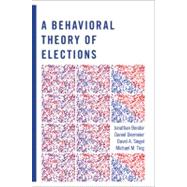
Note: Supplemental materials are not guaranteed with Rental or Used book purchases.
Purchase Benefits
What is included with this book?
| Acknowledgments | p. xi |
| Bounded Rationality and Elections | p. 1 |
| Framing and Representations | p. 5 |
| Heuristics | p. 8 |
| Aspiration-based Adaptation and Bounded Rationality | p. 12 |
| Plan of This Book | p. 21 |
| Aspiration-based Adaptive Rules | p. 23 |
| ABARs Defined | p. 23 |
| Some Important Properties of ABARs | p. 33 |
| The Evidential Status of Aspiration-based Adaptation | p. 46 |
| Party Competition | p. 52 |
| Related Work | p. 54 |
| The Model and Its Implications | p. 56 |
| Informed and/or Sophisticated Challengers | p. 68 |
| Robustness Issues | p. 74 |
| Conclusions | p. 78 |
| Turnout | p. 80 |
| The Model | p. 82 |
| Main Results | p. 85 |
| Variations in Participation | p. 96 |
| Conclusions | p. 107 |
| Voter Choice | p. 109 |
| The Model | p. 112 |
| The Endogenous Emergence of Party Affiliation | p. 116 |
| Misperceptions | p. 121 |
| Retrospection and Prospection Combined | p. 122 |
| Voter Sophistication and Electoral Outcomes | p. 124 |
| Institutions and Unsophisticated Retrospective Voters | p. 128 |
| Conclusions | p. 130 |
| An Integrated Model of Two-Party Elections | p. 132 |
| Full Computational Model for Two Parties | p. 134 |
| Some Results of the Basic Integrated Model | p. 138 |
| The Choices of Voters | p. 141 |
| Party Location | p. 145 |
| Turnout | p. 148 |
| New Questions | p. 152 |
| Conclusion | p. 159 |
| Elections with Multiple Parties | p. 161 |
| Extending Our Results to Multiple Parties | p. 161 |
| Multicandidate Competition and Duverger's Law | p. 166 |
| The Model and Simulation Results | p. 173 |
| An Intuition | p. 180 |
| ABARs and Dynamic Stability | p. 183 |
| Model Meets Data | p. 184 |
| Conclusions: Bounded Rationality and Elections | p. 191 |
| Testing the Theory | p. 194 |
| Normative Considerations: Voter Error and Systemic Performance | p. 196 |
| Extensions | p. 198 |
| Proofs | p. 205 |
| The Computational Model | p. 215 |
| Overview | p. 215 |
| Graphical Model | p. 216 |
| Batch Model | p. 229 |
| Bibliography | p. 233 |
| Index | p. 249 |
| Table of Contents provided by Ingram. All Rights Reserved. |
The New copy of this book will include any supplemental materials advertised. Please check the title of the book to determine if it should include any access cards, study guides, lab manuals, CDs, etc.
The Used, Rental and eBook copies of this book are not guaranteed to include any supplemental materials. Typically, only the book itself is included. This is true even if the title states it includes any access cards, study guides, lab manuals, CDs, etc.